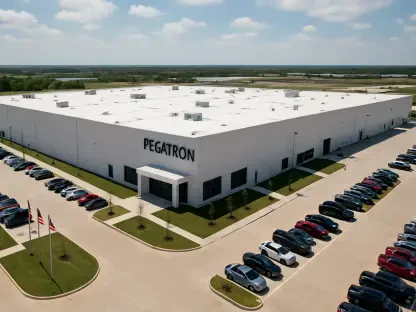Listen to the Article
In today’s fast-moving supply chain world, updating your Warehouse Management System is very important. This key step can completely transform your business operations by making it easier to fulfill orders, keeping inventory records more accurate, and significantly lowering labor costs.
By integrating advanced technologies such as mobile devices, barcode scanning, and automation, businesses can gain real-time visibility, process information at a faster pace, and secure a competitive edge, all while setting the stage for a smoother operation that benefits every aspect of the business, although the ultimate success of this transformation relies on one critical factor: Securing buy-in from stakeholders at every level, including executives and frontline staff.
Securing buy-in means that you achieve complete alignment and full commitment from all stakeholders regarding both the reasons behind the upgrade and the method of its implementation, which involves clearly communicating the benefits, addressing any concerns that may arise, and building a genuine enthusiasm for change across the organization.
This article explains in detail how you can build a strong business case for a Warehouse Management System while also highlighting the market’s leading offerings to help you take that essential first step toward modernizing your operations.
Tell A Story
Start with data-driven storytelling. Identify the quantitative upside of the upgrade by pinpointing inefficiencies in your current operations, such as mis-picks, inventory discrepancies, or delayed shipments.
Establish measurable key performance indicators—order accuracy, labor costs, cycle times—and calculate the potential improvements a modern Warehouse Management System could deliver. If manual processes trigger a high error rate in order picking, translate that into financial losses from returns or rework. Demonstrating how automation could reduce errors and save thousands annually makes the case tangible.
It’s a Numbers Game
Leadership buy-in begins with a compelling ROI narrative. Executives care about outcomes, not just features. Turn technical benefits into financial and operational gains: Reduced labor hours, lower error-related expenses, revenue growth from faster order fulfillment, and flawless inventory accuracy that curtails stockouts and excess costs.
Resistance stems from the belief that the status quo is sufficient. Counter that by spotlighting hidden costs—wasteful manual tasks that drain time and resources. Present data in terms that hit home. For example, you can make the case that saving 10 minutes per task per employee aggregates to hundreds of hours reclaimed each year.
Everyone’s Involved
Engaging stakeholders at all levels is crucial. Leadership support sets the tone, while middle managers bridge to frontline teams. Ensure managers grasp the Warehouse Management System’s purpose and benefits so they can confidently communicate its value. Empower one enthusiastic team member to become a technology champion who demonstrates the system, trains peers, and transforms the workplace culture. Position this role as a career-enhancing opportunity.
Advanced Technology Integration
Embracing new technologies is the fuel behind a modern Warehouse Management System. Integrating IoT sensors, cloud-based data management, and AI-powered analytics drives operational clarity and responsiveness.
Real-time insights become the norm, and streamlined workflows emerge from what used to be chaotic spreadsheets and outdated processes. Digital transformation here is a decisive step forward—a declaration that your organization refuses to be left behind. A culture where data informs every decision creates a resilient, forward-thinking operation that isn’t afraid to disrupt old habits.
Implementing Seamless Integration
A careful rollout plan ensures that training, testing, and troubleshooting are included in the process from day one, thereby making the integration accessible and effective for everyone involved.
Interactive training modules, hands-on workshops, and dedicated support channels guarantee that every user feels competent and excited about the change. When implementation is managed with precision and clarity, the transition morphs into an opportunity for growth rather than a stumbling block.
Building a Culture of Innovation
A Warehouse Management System upgrade is a catalyst for cultural change as much as it is a technical enhancement. Cultivating an environment where every team member embraces improvement is essential. Instill a mindset that celebrates efficiency and smart work over clinging to outdated methods. A workforce that is encouraged to voice ideas and experiment with new processes fuels innovation from within. This is a collective evolution toward operational excellence. Bold leadership and proactive engagement transform cautious skeptics into impassioned advocates of progress.
Measure Impact with Precision
Data does not lie. Establish a robust system of real-time analytics that tracks performance against predefined key performance indicators. Precise measurement of metrics such as order processing speed, inventory accuracy, and labor efficiency empowers you to refine processes continually. This focus on measurable impact ensures that every upgrade decision is backed by clear evidence of success. Continuous monitoring and iterative improvements solidify the gains achieved through the Warehouse Management System transformation.
Selecting the Right Solution
This exploration takes a close look at the exciting changes happening in supply chain innovation—driven by the market’s leading solution providers. Read on to inform your purchasing decisions and build a basis for your business plan.
Körber Warehouse Management Systems
Körber provides a broad range of proven end-to-end solutions tailored to help manage the supply chain as a competitive advantage. Fitting any business size, strategy, or industry, organizations can conquer the complexity of the supply chain with their portfolio of software, voice, and robotics solutions. Körber is recognized as a software development company offering a variety of value-added services, noted for “navigating through K-WMS’s high level of autonomy and easy interfacing” and praised for being a good partner in implementing long-lasting solutions.
Blue Yonder
Blue Yonder software and services drive digital supply chain transformation, empowering retailers, manufacturers, and logistics service providers worldwide to optimize and accelerate their operations from planning through fulfillment, delivery, and returns. Blue Yonder’s AI-driven supply chain platform and multi-enterprise, multi-tier network enable more accurate forecasting and dynamic management of capacity, inventory, and transport. The company is celebrated for its feature-rich, highly configurable, and revolutionary products and services that meet the rising demand for tailored warehouse solutions.
Microsoft Dynamics 365 Supply Chain Management
Microsoft enables digital transformation in the era of an intelligent cloud and intelligent edge, with a mission to empower every person and every organization to achieve more. The company is dedicated to advancing human and organizational achievement while its security solutions protect data and people against cyber threats. Microsoft is recognized for delivering great overall functionality with flexible configuration options and a system structure that provides solid support alongside discussions about the application of advanced warehousing.
Oracle
Oracle is a global cloud technology company offering computing infrastructure and software solutions. It is known for developing the first autonomous database to manage and secure data. Oracle Cloud Infrastructure facilitates the seamless transition of workloads between on-site systems, different clouds, or a hybrid environment, while its cloud software applications support sustainable growth and resilience in businesses of all sizes. Oracle’s solutions are applied in various domains, from supply chain streamlining and human resource management to financial planning and global data connectivity. They provide a positive experience in Oracle Cloud WMS product selection and implementation, success in life science and distribution industries, and the ability to continually evolve through available solutions and features.
SAP
SAP aims to improve operational efficiency worldwide by helping customers optimize their business operations through innovative solutions. The company plays a crucial role in transforming industries by fostering opportunity and equality on a global scale and collaborating with customers and partners to make substantial changes across various sectors. SAP is lauded for the perks of easy integration with other products, its approach to navigating support challenges and archiving requirements, and its comprehensive understanding of the complex setup of Extended Warehouse Management applications.
Final Thoughts
A modern Warehouse Management System upgrade goes beyond simple software implementation and becomes an organizational shift in which every stakeholder, from the boardroom to the warehouse floor, plays an important role. With strategic investment in the right technology, cohesive integration planning, and a strong drive for innovation, you can enhance productivity and sustainable growth.
By securing stakeholder buy-in and building the foundation for transformation, you are ensuring the future of your supply chain operations.









